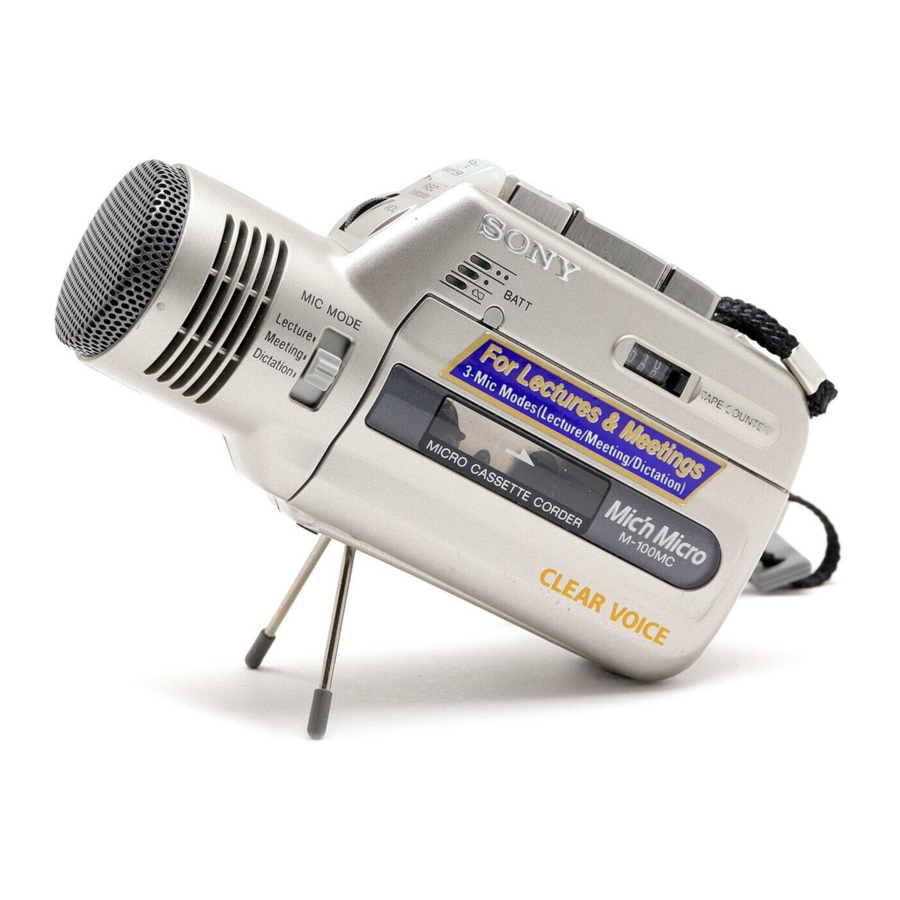
SONY M-100MC - Microcassette Recorder Operating Instructions
- User manual (14 pages) ,
- Service manual (14 pages) ,
- Operating instructions manual (6 pages)
Advertisement

Welcome
Thank you for purchasing the Sony Microcassette-Corder. Some features are:
- The three modes (Lecture, Meeting, or Dictation) allow you to switch the microphone sensitivity and directionality so that the microphone picks up the sound clearly depending on the recording situation.
- The recorded sound is loud and clear with high power output.
- The BATT lamps indicate remaining battery power in two steps and the
![]() lamp indicates when to replace the batteries.
lamp indicates when to replace the batteries. - The CUE MARKER function locates a specific position of a dictation.
- The FAST PB (fast playback) function enables you to review the contents approx. 20% faster than normal playback.
- The VOR (Voice Operated Recording) system starts and stops recording automatically in response to the sound.
- Edit function—You can start recording directly from the playback mode by pressing the
![]() button to correct a previously recorded portion.
button to correct a previously recorded portion. - Tape counter
- Automatic shut-off mechanism at the end of the tape (in the recording/playback mode only)
- Stop-pause-release function—The PAUSE switch is released automatically when the
![]()
![]() button is depressed, so that you don't miss a recording chance.
button is depressed, so that you don't miss a recording chance.
Preparing Power Sources
Choose one of the following power sources.
Dry Batteries
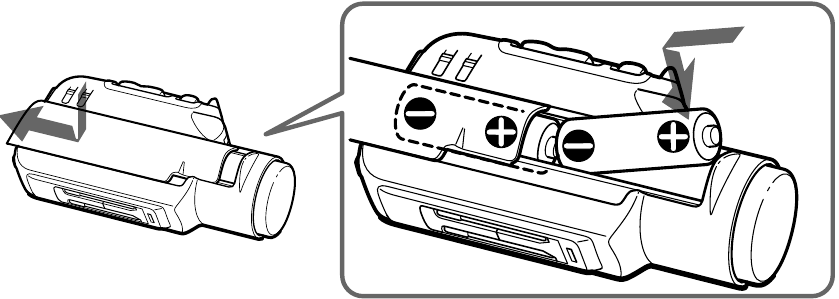
Make sure that nothing is connected to the DC IN 3V jack.
- Open the battery compartment lid.
- Insert two R6 (size AA) batteries with correct polarity and close the lid.
To take out the batteries
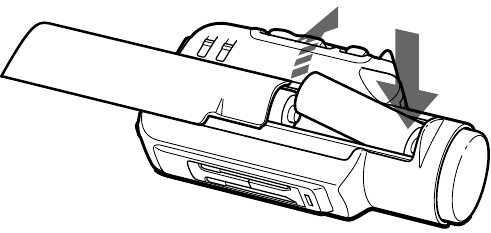
To attach the battery compartment lid, if it is accidentally detached

Attach it as illustrated
When to replace the battaries
Replace the batteries with new ones when the BATT indicators go off and the  indicator flashes. The BATT indicators change as illustrated:
indicator flashes. The BATT indicators change as illustrated:

When batteries are new

When batteries become weak

Replace batteries
Notes
- The unit will play back normally for a while, even after the i indicator flashes. However, replace the batteries as soon as you can. If not, the playback cannot be made with normal sound, noise may be recorded and the recorded sound will not be loud enough.
- The i indicator flashes to indicate battery replacement during playback, recording and pause (during pause by VOR function also).
- In the following cases you do not need to replace the batteries:
- if the BATT indicators flash with the playback sound when you turn up the volume.
- if the
![]() indicator lights momentarily when the tape starts running or at the end of the tape.
indicator lights momentarily when the tape starts running or at the end of the tape. - if the
![]() indicator flashes during fast forward/CUE or rewind/ REVIEW.
indicator flashes during fast forward/CUE or rewind/ REVIEW.
Battery life* (Approx. hours)
| Batteries | Recording |
| Sony alkaline LR6 (SG) | 16.0 |
| Sony R6P (SR) | 5.5 |
* Measured value by the standard of JEITA (Japan Electronics and Information Technology Industries Association) (Using a Sony Microcassette MC-60)
Note
The battery life may shorten depending on the operation of the unit.
House current
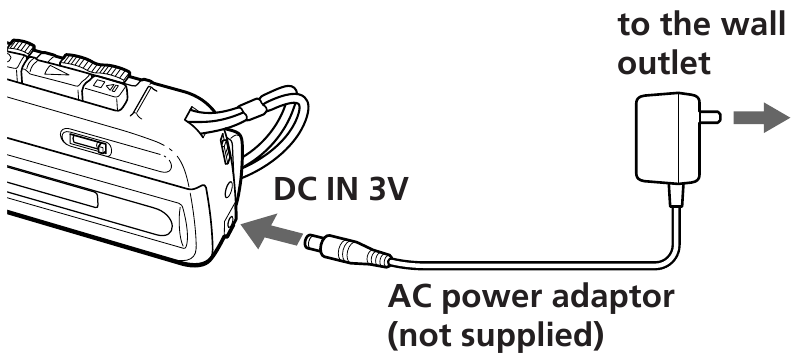
Connect the AC power adaptor to the DC IN 3V jack and to a wall outlet. Use the AC-E30HG AC power adaptor (not supplied). (For World model: In Japan, use the AC-E30M, not supplied.) Do not use any other AC power adaptor.

Polarity of the plug
Note
Specification for AC-E30HG varies for each area. Check your local voltage and the shape of plug before purchasing.
How to use the stands
You can position the unit to record the sound more clearly using the stands. You can choose from the two types of stands depending on the recording situation.

Insert the rubber stand attached to the handstrap into the slot on the bottom of the unit.
To attach the stand if it is accidentally detached

Attach it as illustrated.
Recording

- Press the reset button of the TAPE COUNTER.
- Press
![]()
![]() and insert a standard microcassette with the side to start recording facing the lid.
and insert a standard microcassette with the side to start recording facing the lid. - Select the desired tape speed.
2.4cm for optimum sound (recommended for normal use): A 30-minute recording can be made using both sides of the MC-30 microcassette.
1.2cm for longer recording time: A 60-minute recording can be made using both sides of the MC-30 microcassette. - Set MIC MODE to select the sensitivity of the microphone (see "Using the MIC MODE selector").
Lecture: to record the sounds from where the unit is aiming (uni-directional). It is useful to record during a lecture.
Meeting: to record at meetings or in a quiet or spacious place (omni-directional).
Dictation: to record for dictation or in a noisy place (omnidirectional). - Set VOR to ON or OFF.
If you set VOR to ON, the unit automatically starts recording the sound and pauses when there is no sound (you can save tapes and batteries). When the sound is not loud enough, set it to OFF, or the unit may not start recording. - Press
![]() .
.
Recording starts. While the tape runs, the REC indicator lights and flashes depending on the strength of the sound.
| To | Press or slide |
| Stop recording |   |
| Start recording during playback |  during playback (the unit becomes in the recording mode) during playback (the unit becomes in the recording mode)The REC indicator lights. |
| Review the portion just recorded | Slide  CUE/ CUE/  REVIEW toward 0REVIEW during the recording. REVIEW toward 0REVIEW during the recording.Release it at the point to start playback. |
| Pause recording | Slide  PAUSE in the direction of the arrow. The REC and BATT indicators go off. PAUSE in the direction of the arrow. The REC and BATT indicators go off.To release pause recording, slide  PAUSE in the opposite direction. PAUSE in the opposite direction. |
| Take out a cassette |   |
Note
Select the 2.4 cm tape speed for recording, if you play back the recorded tape with another unit. Otherwise, the sound quality may be changed.
Notes on VOR (Voice Operated Recording)
- The VOR system depends on the environmental conditions. If you cannot get the desired results, set VOR to OFF.
- When you use VOR in a noisy place, the unit will stay in the recording mode. If the sound is too soft, on the contrary, the unit will not start recording.
Using the MIC MODE selector
Set MIC MODE to the desired position depending on the recording situation.

To monitor the sound
Connect the earphone (supplied to World model only) to EAR jack. The monitor volume cannot be adjusted by VOL.
To prevent a cassette from being accidentally recorded over
Break out and remove the cassette tabs. To reuse the cassette for recording, cover the tab hole with adhesive tape.

Recording cue marks
While recording, you can record a special signal on the tape to mark a specific position.
At the desired position, push CUE MARKER to record a signal.
The REC indicator goes off for a while and a signal will be recorded on the tape. If you want to record a signal longer than that, push CUE MARKER as long as you want.
During cue and review, you will hear the beep sound at the signal position. During playback, you will hear the signal with low frequency.
Notes
- We recommend recording cue marks when there is a break in the sound.
- During cue and review, the beep sounds differently.
- The beep may sound differently depending on the marked position on the tape because the winding speed varies from the beginning to the end of the tape.
Playing a Tape

- Insert a cassette with the side to start playing facing the lid.
- Set TAPE SPEED to the same speed as that used for recording.
- Press
![]() .
. - Adjust the volume.
| To | Press or slide |
| Stop playback/stop fast forward or rewind* |   |
| Pause playback | Slide  PAUSE in the direction of the arrow. The BATT indicators go off. To release pause playback, slide PAUSE in the direction of the arrow. The BATT indicators go off. To release pause playback, slide  PAUSE in the opposite direction. PAUSE in the opposite direction. |
| Fast forward | Slide  CUE/ CUE/  REVIEW toward REVIEW toward  CUE during stop.** CUE during stop.** |
| Rewind | Slide  CUE/ CUE/  REVIEW toward REVIEW toward  REVIEW during stop.** REVIEW during stop.** |
| Search forward during playback (CUE) | Keep  CUE/ CUE/  REVIEW sliding toward REVIEW sliding toward  CUE during playback and release it at the point you want.** CUE during playback and release it at the point you want.** |
| Search backward during playback (REVIEW) | Keep  CUE/ CUE/  REVIEW sliding toward REVIEW sliding toward  REVIEW during playback and release it at the point you want.** REVIEW during playback and release it at the point you want.** |
* If you leave the unit after the tape has been wound or rewound, the batteries will be consumed rapidly. Be sure to depress 
 .
.
** The tape moves faster in the rewind/REVIEW mode than in the fast forward/CUE mode.
Note
If the tape is completely rewound while searching backward during playback (REVIEW),  CUE/
CUE/  REVIEW may not return to the center position when you release it. In this case, push it back to the center position to start playback.
REVIEW may not return to the center position when you release it. In this case, push it back to the center position to start playback.
To increase the playback speed
Slide the FAST PB switch in the direction of the arrow. The playback speed will be increased.
To return to the original speed, slide the FAST PB switch to the original position.
At the end of the tape
In the recording or playback mode, the tape stops at the end of the tape and the locked buttons will be released automatically (Automatic shut-off mechanism).
After fast forward or rewind, be sure to set  CUE/
CUE/  REVIEW back to the center position.
REVIEW back to the center position.
Dubbing onto another tape recorder
Connect another tape recorder using the RK-G64 connecting cord (not supplied).
Set this unit to the playback mode and another tape recorder to the recording mode.

Precautions
On power
- Operate the unit only on 3 V DC.
For AC operation, use the AC adaptor recommended for the unit. Do not use any other type. For battery operation, use two R6 (size AA) batteries.
On the unit
- Use only the
![]() (standard microcassettes) with this unit. Non-standard cassettes cannot be used because their "L" dimension (see illustration) is different.
(standard microcassettes) with this unit. Non-standard cassettes cannot be used because their "L" dimension (see illustration) is different.
![SONY - M-100MC - On the unit - Diagram On the unit - Diagram]()
Only standard microcassettes have a small indention of side A. - Do not leave the unit in a location near heat sources, or in a place subject to direct sunlight, excessive dust or mechanical shock.
- Should any solid object or liquid fall into the unit, remove the batteries or disconnect the AC power adaptor, and have the unit checked by qualified personnel before operating it any further.
- Keep personal credit cards using magnetic coding or springwound watches etc. away from the unit to prevent possible damage from the magnet used for the speaker.
- When you do not use the unit for long, remove the batteries to avoid damage caused by battery leakage and subsequent corrosion.
- If the unit has not been used for long, set it in the playback mode and warm it up for a few minutes before inserting a cassette.
If you have any questions or problems concerning your unit please consult your nearest Sony dealer.
Troubleshooting
Should any problem persist after you have made these checks, consult your nearest Sony dealer.
A cassette cannot be inserted.
- The cassette is being inserted in the wrong way. (The cassette should be inserted in the lid with the tape side facing upward.)
![]() ( has been already pressed.
( has been already pressed.
 cannot be pressed.
cannot be pressed.
- There is no cassette in the cassette compartment.
- The cassette tab has been removed.
 or
or  cannot be pressed.
cannot be pressed.
- The tape has reached the end.
- After the automatic shut-off,
![]() PAUSE is slid in the direction of the arrow.
PAUSE is slid in the direction of the arrow.
The unit does not operate.
- The batteries have been inserted with incorrect polarity.
- The batteries are weak. Replace both batteries with new ones.
![]() PAUSE is slid in the direction of the arrow.
PAUSE is slid in the direction of the arrow. - The AC power adaptor or car battery cord is connected to the unit only and you are going to use the unit on batteries.
No sound comes from the speaker.
- The earphone is plugged in.
- The volume is turned down completely.
The sound drops out or comes with excessive noise. n The volume is turned down completely.
- The batteries are weak. Replace both batteries with new ones.
- The head is contaminated. See "Maintenance".
During CUE/REVIEW, the tape stops or does not run. Or you cannot fast-forward or rewind.
- The batteries are weak. Replace both batteries with new ones.
Tape speed is too fast or too slow in the playback mode.
- Improper setting of the TAPE SPEED switch. Set it to the same speed as that used for recording.
Tape speed is faster than the normal playback speed.
- The FAST PB switch is slid in the direction of the arrow.
Recording cannot be made.
- The batteries are weak. Replace both batteries with new ones.
- The head is contaminated.
- The VOR switch is set to ON. When you do not use VOR, set it to OFF.
- Set the MIC MODE selector firmly at the correct position. Recording is interrupted.
- The VOR switch is set to ON. When you do not use VOR, set it to OFF.
Recording cannot be erased completely.
- The head is contaminated.
Maintenance

To clean the tape head and path
Press  and wipe the head, capstan and the pinch roller with a cotton swab, moistened with alcohol every 10 hours of use.
and wipe the head, capstan and the pinch roller with a cotton swab, moistened with alcohol every 10 hours of use.
To clean the exterior
Use a soft cloth slightly moistened in water. Do not use alcohol, benzine or thinner.
Specifications
Tape
 (normal position type)
(normal position type)
Recording system
2-track 1-channel monaural
Speaker
Approx. 2.8 cm (11⁄8 in.) dia.
Tape speed
2.4 cm/s (15⁄16 ips), 1.2 cm/s (15⁄32 ips)
Frequency range
"Lecture": 400 - 3,000 Hz
"Meeting", "Dictation": 400 - 4,000 Hz
Output
Earphone jack (minijack) for 8 – 300 ohms earphone
Power output (at 10% harmonic distortion)
220 mW
Battery life (recording)
See "Preparing Power Sources".
Power requirements
3 V DC
Two R6 (size AA) batteries
Dimensions (w/h/d)
Approx. 126.0 × 68.0 × 40.8 mm (5 × 23⁄4 × 15⁄8 in.) incl. projecting parts and controls
Mass
Approx. 180 g (6.4 oz) incl. batteries
Supplied accessories
Hand strap (attached to the unit) (1)
Microcassette tape (1) (Except for U.S.A., Canadian and European models)
Wind screen (1) (U.S.A., Canadian, European and World models only)
R6 (size AA) batteries (2) (World model only) Earphone (1) (World model only)
Design and specifications are subject to change without notice.
Optional accessories
Microcassette MC-60, MC-30
Earphone ME-81, ME-L82
Connecting cord RK-G64 (miniplug to miniplug with attenuator)
AC power adaptor AC-E30HG, AC-E30M
Car battery cord DCC-E230, DCC-E345

Documents / ResourcesDownload manual
Here you can download full pdf version of manual, it may contain additional safety instructions, warranty information, FCC rules, etc.
Download SONY M-100MC - Microcassette Recorder Operating Instructions
Advertisement
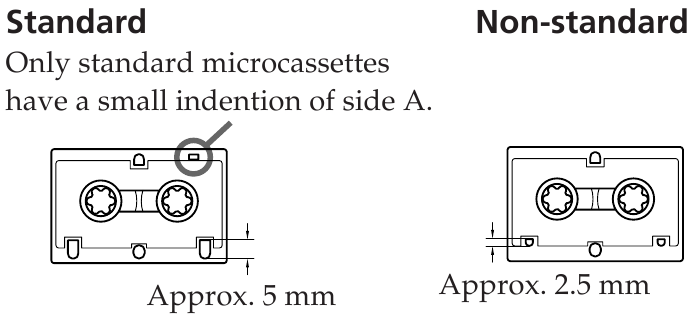
















Need help?
Do you have a question about the M-100MC and is the answer not in the manual?
Questions and answers